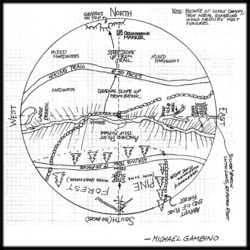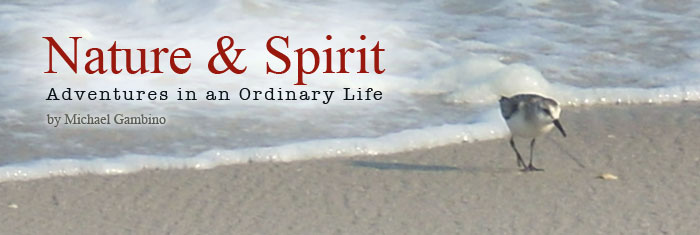Finding Your Sacred Area in Nature – Part 2
 Sunday, April 18, 2010 at 09:18AM
Sunday, April 18, 2010 at 09:18AM Sorry for the delay in delivering Part 2 of this series. Hopefully you have had some time to locate a suitable spot for this practice of nature observation as discussed in Part 1. Remember that you must use common sense in picking a spot that is safe, too! At least one other person you can count on should know where you place is, but ideally, they should not visit your space uninvited.
Once you have a spot, what are you supposed to do there? Well, many things or nothing, really. Essentially your sacred area is a place where you can immerse yourself in the rhythms of nature taking note of the experience within you and the activity around you. You can sit or wander about as you like. As any good observer or explorer would do, you will begin by making a map of your sacred area, noting prominent features of the landscape and noting the cardinal directions (NSEW). You may add as much detail as you like to one map, but it will get confusing fast. It would be better to make a base map of the landscape marking down locations of stone walls, boulders, tree stumps, animal trails, water features, prominent trees and vegetative features, swamps, slopes, etc. You will need to use a birds eye view for best results. That is, envision your space as though you were flying above it all, looking down. Make your map using symbols (for trees, boulders, etc.) that makes sense to you, and include a map legend on the paper as well with a brief description of what each symbol means.
Here is an example from my own journal (Click image for larger view):
 Note that the map can be rotated. When drawing your map, stand at the center of your space facing each of the four directions and place your words and symbols as if they are at the "top" of your drawing.
Note that the map can be rotated. When drawing your map, stand at the center of your space facing each of the four directions and place your words and symbols as if they are at the "top" of your drawing.
Once you have drawn a map of your sacred area, leave it at home, but commit it to memory. Sitting in your area, simply relax and take in the sounds, smells, textures, and sights. Note the time of day and weather as well as season. After several trips to your area at your usual time, vary the time of day you visit because you will gain new insights about your sacred area. Animals follow intervals of activity and rest through out the day, with different species being more active during early morning than late morning, while others are active the afternoon or at twilight.
When you arrive at your spot each time, sit comfortably in the center of your area and take a few deep breaths and relax. Slow down, both internally and externally. Once you are in sync with the flow of the landscape you will be mostly invisible to the creatures that live there or pass through it. Often I have experienced wondrous changes in my consciousness, perceptions, and have seen animals I would not have otherwise seen had I just been hiking through the area. Your patience and attention will be rewarded many times over.
Each time you visit, consciously ask yourself “what is happening here?” Use your senses deliberately – what are you smelling, hearing, feeling, seeing, etc. Our senses are such powerful gifts and usually it feels really good to engage them this way. This is active rather than passive meditation and observation. You will probably find that you feel refreshed, calmer, and even happier at the end of your time being in your sacred area. You might also experience what is really going on in your body, mind, spirit, and emotions. You may realize the depth of your fatigue, or the amount of caffeine you had, or you might become aware of body aches and complaints. Just notice all that you experience and observe, making notes when you return home.
Commit your observations to memory, and when your allotted time is up, leave quietly. It is best if you can return home and immediately make notes in your journal. Reference your paper map and make some additional notes to it if needed. The key here is using your “mind’s eye” to recall the experience and observations. This is an important element to the practice of nature observation and recall.
Over the course of years, many of us have our naturally sharp awareness dulled by the daily assault on our physical and emotional senses. Information overload has a numbing effect on our sensitivity. We spend so much time using our left-brain logic-processing centers to do our jobs, run our businesses, care for our family, and otherwise handle modern life’s daily demands. Often this means we push “slower” or “non-productive” seeming activities off our schedule when we feel pressed for time. (Sleep is our most commonly raided “time bank”.) There is a hidden price we pay when we strip away daily quietude, solitude, and creative and spiritual self-practice. Remember the “use it or lose it” clause in the evolutionary handbook? If we lose our ability to relate personally to the natural world from whence we came, then we are losing a vital and fundamental aspect of who we are, and it can ultimately be a detriment to the environment. Fortunately, we can remedy this situation by consciously engaging with subtle aspects of nature regularly.
This sacred area (or "secret spot") practice is a tradition that comes from the Cherokee people, and is one way to help awaken your senses and observation skills again. It may not seem like much–spending 15 minutes a day – but as the days go by you will develop a new understanding and ability to see nature. You could spend an entire lifetime of daily observation in your sacred area and still not exhaust the wonder and magic revealed to you by that small area of the earth. Your sacred area or secret spot will become one of your best friends and teachers.
In a future post, I’ll cover some details of keeping a naturalist’s journal and some tools you may want to add to your naturalist field kit.

Reader Comments